Trademarks and Region Locks on the Sega Genesis
Region locks and licensing restrictions are something that I think most gamers find more frustrating than anything else. Why can’t I just play the game if I have it? And that’s certainly true. Nevertheless, I think they’re interesting from the point of a technical solution to a difficult problem (computers like to run code, it’s what they do), and if you click on a blog post about that, maybe you do too. I’ve seen a lot of misinformation here, so I’m going to try to clear things up.
Summary
This blog post will have two major parts: One in which I describe Sega’s region and trademark locks in detail, to the best of my ability, and then a second part where I go through and test them.
I’m making this blog post because in my last blog post, I noticed that Phantasy Star II ran fine on the Pioneer Laseractive. I’ll go into more detail later why I found that interesting.
If you’re already familiar with the locks, or just want to get to the testing part, click here, as you’ll probably find it way more interesting. Otherwise, keep reading!
The Problem
Today, if you want to restrict who accesses something on a computer, there’s a simple solution: cryptography. Well, modern cryptography isn’t simple, but it’s understandable enough, and when done right, is essentially unbreakable. Combine that with internet-connected consoles that can update when things aren’t done right, and you generally need to get lucky with things like unpatchable firmware to get around it.
The Sega Genesis was released in 1988. (Yes, it was the Mega Drive that was released that year. Just like in my past post, I’m going to use the American names for things because it’s what I’m familiar with) Private-key cryptography is regulated by the United States government as a munition, so that’s right out, and anyways, the system has a 7.6 MHz Motorola 68000 main CPU. It’s a nice processor compared to the 8-bit ones that usually feature on this blog, but let’s not get ahead of ourselves.
Another thing to keep in mind is that this is before the Digital Millennium Copyright Act. Circumvention of electronic locks was entirely legal, and even encouraged.
There are essentially two goals here:
- Region locking. For Sega in the 1980s, this seems to have usually consisted of two regions, Japan and Not-Japan. Region locking allowed companies to control licensing, and not have to worry about cheaper games being imported to more expensive regions.
- Licensing. Nintendo introduced the Nintendo Entertainment System in 1985, and with it created a very harsh licensing regime. This ensured profits flowed to Nintendo, and theoretically made sure that all of the games met a standard of quality. As we all know, there were no bad NES games because of this.
The Nintendo lockout chip had a major flaw: it was an electronic lock, not a legal barrier. If someone was able to cleanly engineer a way to bypass the lockout chip (as Color Dreams did), then there would be nothing Nintendo could do. Well, that isn’t quite right, as thanks to their system’s popularity they had a lot of leeway over retailers. But Sega, coming from behind in market share, wouldn’t have the same leeway.
In this section, I’m going to look into what I’ve been able to find about the region locking in the Genesis, primarily from online sources. We’ll do some testing later on to see what else is here.
Sega Master System
Region locking
The Sega Master System was released in the US in 1986. However, the equivalent hardware in Japan was the 1985 SG-1000 Mark III, which was a successor to Sega’s 1983 SG-1000 console, compatible with the same cartridges and cards, as well as any SC-3000 software that didn’t require the keyboard.Since I don’t have a Mark III, I’ll show a a SG-1000 cartridge for comparison instead.
The SG-1000 was released in Europe and Oceania, but not America. It had no region lock whatsoever; like the Japanese Famicom, it had no boot ROM and no restriction. The Mark III continued this, though it did have a boot ROM, it had to remain compatible with past software so performed no checks.
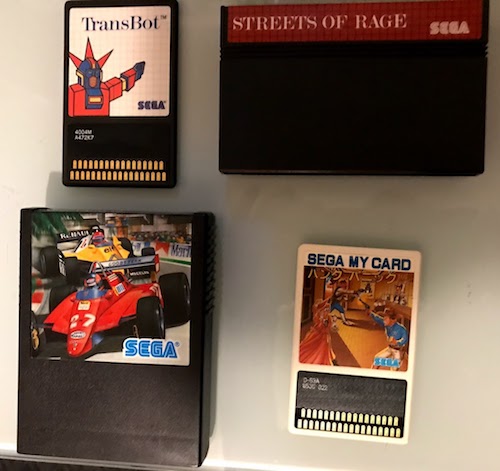
On the other hand, the Master System as released in the West used a different pinout, and a different cartridge shape. Card games used the same pinout and shape, but all games featured a ROM header. The boot ROM read the ROM header, detected the correct region, and refused to play games it couldn’t read.

Trademark
The Western Sega Master System also implemented a trademark-based security system. The first eight bytes of the ROM header had to say “TMR SEGA” for the game to boot.
Trademark law was an interesting idea for Sega. Because of its odd legal status, Taiwan (by which I mean the Republic of China) did not join international copyright treaties until 2001. However, they did prosecute counterfeiters for trademark violations. This is a major reason why pirated games usually seek to remove copyright and trademark notices. (My source for this, and for Sega’s motivations generally, is the Ninth Circuit’s decision in Sega v. Accolade. Wow I’m citing legal documents, I’m so cool and this is such a serious blog)
The Sega Master System was not very popular in many regions, and this doesn’t seem to have ever become a major issue. (I don’t know much about the European side of this, but it seems that the European publishers who didn’t want to pay for a Sega license instead simply hung out in the flourishing home microcomputer market) Sega’s next console, however, was another story.
Sega Genesis
The Sega Genesis was an impressive machine at its debut. Unlike the PC Engine/TurboGrafx-16, it had a true 16-bit CPU (some, like Atari’s Jack Tramiel, would even call it a 32-bit one) and multiple scrolling parallax layers.
But we’re not here to insult the poor innocent PC Engine. Technologically, at its launch the Genesis was actually inferior in terms of protection to the Master System. The physical shape of cartridges differed between regions, but the pinouts were identical. The Japanese Model 1 Mega Drive had a locking piece of plastic that went into a notch in the cartridge. The American system did not have that notch, and had thinner cartridges. Therefore, the same printed circuit board could be used in different regions, only needing to change the plastic.
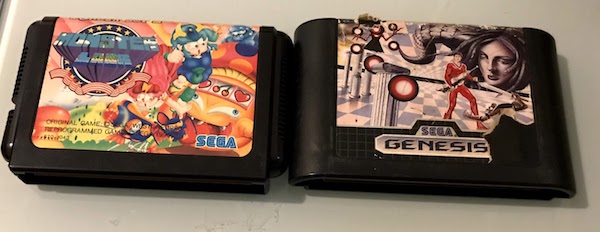
As an aside, this is why if you find poor-quality reproductions, or modern games, you usually see a cartridge that looks like an American cartridge, but has a slot in the side. That’s the only shape that’s guaranteed to fit into every Sega Genesis model sold, even though no games from the Genesis’ era used that shape.
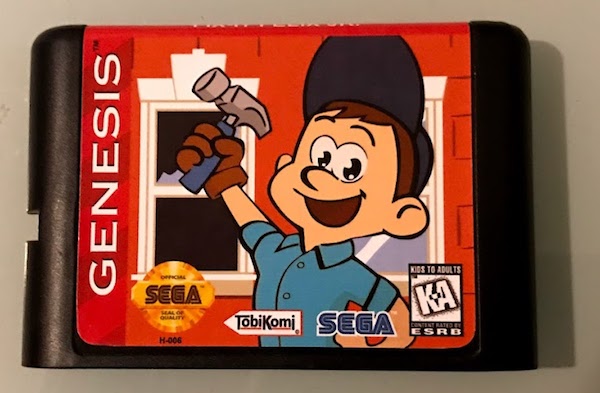
And… that’s it! Early Model 1 Genesises have no other protection. Electronic Arts, familiar with the Motorola 68k as a major developer on the Amiga, originally intended to not get a license from Sega at all. (We’ll go back to the later) If the cartridge fits, it’ll play it. But there’s something a little odd here.
The TradeMark Security System (TMSS)
Sega v. Accolade claims the TMSS as used in the Genesis was licensed from another company, but I can’t find which company it was. In any case, almost all Sega Genesis games from Sega do the following:
- Have the string “SEGA” or “ SEGA” (with a space, for some reason) at address $100 in the ROM, as part of the header
- Write the 16-bit words corresponding to ASCII “SE” and “GA” to a special address
As noted, neither Accolade nor Electronic Arts actually knew why the games did this. (As for the Sega games which didn’t do that, we’ll talk about that later)
In January 1991, Sega released what Sega v. Accolade confusingly calls the “Genesis III”. This appears to be what the modern community calls the VA6 motherboard of the Model 1 Genesis. This introduced the TradeMark Security System (TMSS). How it works is fairly simple.
First off, a new boot ROM reads the ROM at address $100 and looks for the string “SEGA” or “ SEGA”. If it finds it, it displays a trademark message.
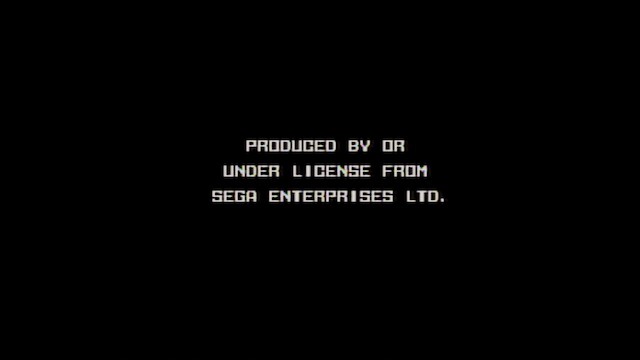
Following this, the boot rom disables the graphics chip of the Genesis, the Video Display Processor (VDP). It can only be enabled if the game ROM writes bytes corresponding to “SEGA” to the special address. If the VDP is off, the game simply won’t have graphics. (Though the VDP controls this process, this also prevents sound).
This meant that, were someone to circumvent this process, Sega would have two tools they could use against would-be developers, which they used in Sega v. Accolade:
- Copyright. The code to write to the VDP was copyrighted by Sega. Any would-be reverse engineer would have to copy it in whole, and therefore, violate Sega’s copyright.
- Trademark. Any game that met the requirement would claim to have been produced under license by Sega. Any games not produced under license, therefore, would be violating Sega’s trademark.
As it turns out, the court saw through this attempt and considered it a fair use.
After Sega v. Accolade
Sega and Accolade settled their court case, and there doesn’t seem to have been much of a followup. The market for unlicensed games in the US dried up; I imagine the ESRB (and its Sega-controlled predecessor the Videogame Rating Council) played a major role in that. Soon enough, retailers wouldn’t sell a game that was unrated, and the ESRB didn’t rate unlicensed games.
Nevertheless, the Taiwanese pirates Sega was concerned about remained a problem, and TMSS appears to have remained a useful tool against them. All later Genesis models kept using it. (I’m not sure if this extends to the AtGames units, but it definitely did to the Majesco-made “Genesis 3”, which again, is not the same thing as the “Genesis III”.)
Sega redesigned the Genesis in 1993, giving it a smaller, cheaper case. And they used this as an opportunity to get rid of the plastic tab that prevented US Genesis games from fitting into Japanese Model 1 Mega Drives. All American games now fit into Japanese systems, though the opposite case still wasn’t true.
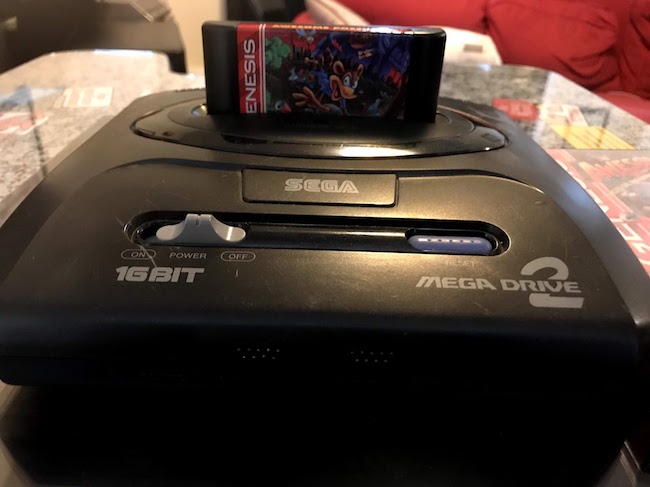
The system has one more trick up its sleeve, though. From the beginning, it had a byte the game could check to see what region console it was running on. Early on, this was mostly only used for games like Mystic Defender (Kuajku Oh 2 in Japan), so that they could use the same ROM in both regions but still show different text and graphics.
These two screenshots are from the same cartridge. First played on my Sega CDX (US model), then my Mega Drive 2 (Japanese model).
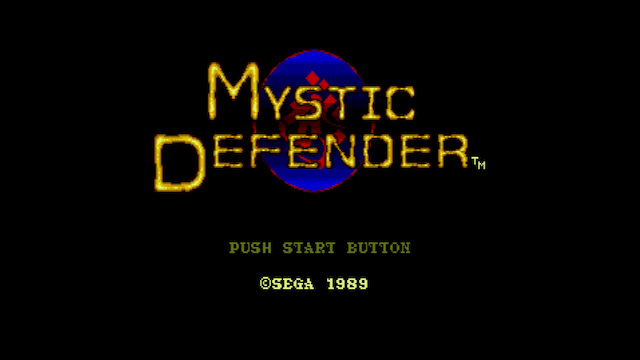
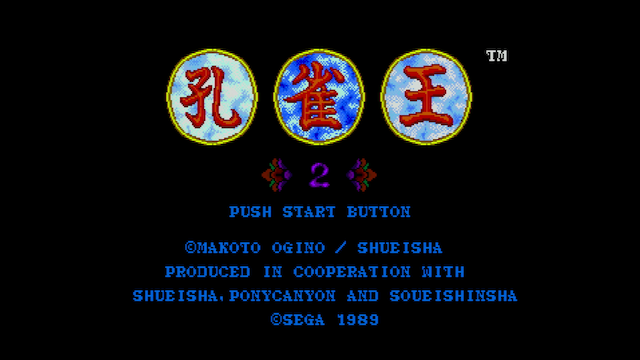
However, this was really only feasible for games that had a small enough amount of regional differences that they could fit everything in a small ROM. Therefore, you don’t see this as often later in the system’s life.
Instead, especially from 1993 onwards, it became very common for games to have different ROMs in each region, and have those ROMs check the region. This is basically doing the reverse of the Master System; instead of the console checking the game, the game checks the console. This means that if I try to run my US copy of Virtua Racing on the above two consoles, we see something different:
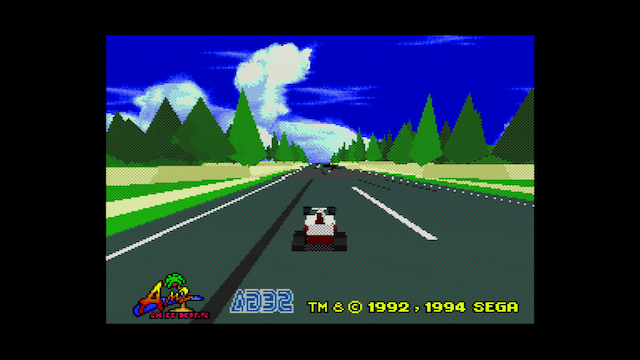
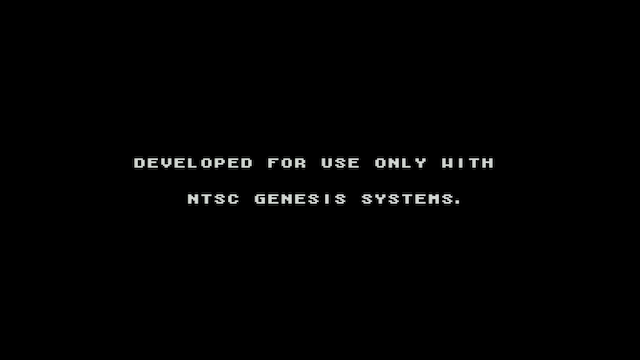
It’s worth noting that this is all in software. When a game fails TMSS, it doesn’t get to run at all. Virtua Racing, from a computer standpoint, is running just fine. It’s just that the game code doesn’t do anything interesting unless it detects the right region code.
Circumvention
All this is well and good, Nicole, and maybe even interesting as a solution to a difficult problem, but in the end it’s just annoying for gamers. Who wants to have three Genesises under their TV just to play games from any region? Who wants to wait an extra second to play every single game just to let the system display a trademark message?
Circumventing hardware region locks
The US and Japanese Genesises have the same exact pinout. It’s just the plastic shell that prevents games from running. So all you have to do is widen the hole, or remove your game cartridges from their shell.
Maybe you don’t want to do that. You can easily find cheap slot extenders like this one:
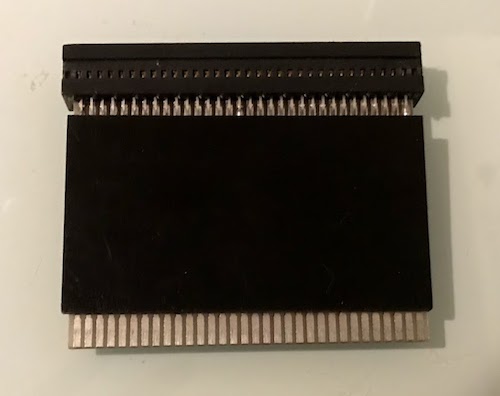
They’ve stuck some black plastic to the outside, but literally all the traces on this PCB are just straight lines, you can beep it out with a multimeter. Therefore, this won’t get around TMSS or anything the software itself does. But if you want to just make the pins connect, this’ll do the job.
Circumventing TMSS
If you saw the above photo, you probably thought “hey, I have a Game Genie, isn’t that the same thing?” And the answer is yes, yes it is. But a Game Genie goes a step further.
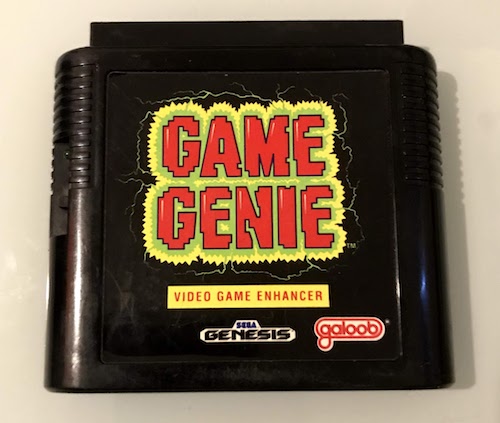
See, the Game Genie has a ROM of its own, and it’s a licensed product. That means that it has TMSS. Specifically, it has TMSS from the cartridge viewpoint, it doesn’t enforce it on any cartridges. Therefore, if the only issue with your game is that pesky TMSS, this’ll clear it right up.
Or you could just a Genesis from before the VA6 hardware revision of the Model 1. They can be distinguished from the outside shell, most of the time.
Circumventing software region locks
In the above two cases, you’re trying to get the game to run. But as I noted above, software locked games like Virtua Racing are running just fine. There’s nothing you can do about that, without hard-modding your console to add region switches. This isn’t a guide to doing that, but it can be done. All these switches will do will change what bytes the game reads when it looks to see what region it’s in.
This is also why you sometimes see region switches on clone systems that claim to support Genesis games; they usually only change what region the games will find. I believe the Analogue Mega SG, a higher-end clone, handles it using menus, but I don’t have one to confirm.
Putting them to the test!
Is this what you came here for? It’s what I came here for. I’ve assembled a battery of test games, and of four representative systems.
The Consoles
American consoles
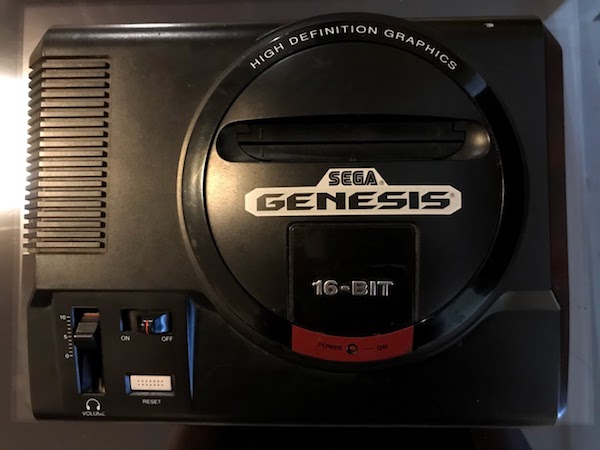
We start with a Model 1 Genesis. This one has PCB revision “VA3”, which has good sound, video through a Master System-style AV port, and most importantly, no TMSS. This console works just fine; it’s a recent addition to my collection, as I noted back in the last post I didn’t have one. Well, I do now. Let me know if you want me to go back and record Emerald Hill Zone.
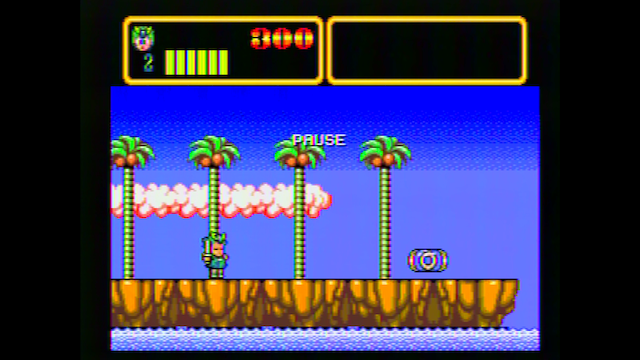
It does suffer from rainbow banding. I only have a composite cable for this console, but it can do RGB, so maybe I’ll get a cable at some point. The good ones seem to be more expensive than I paid for the console, though…
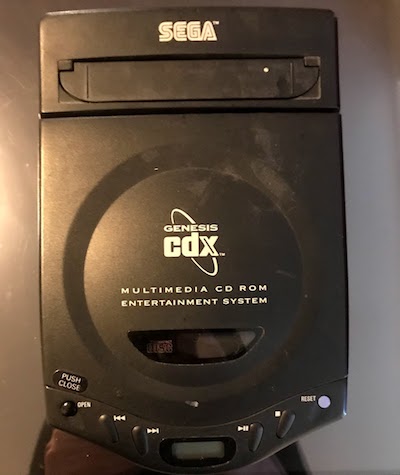
And making its return from last week, it’s my Sega CDX. This is a perfect example of a late model Genesis. Released in 1994, it features TMSS, the later mini-DIN based AV output, but it’s also not plagued by the poor quality sound many Model 2 systems suffered with. For the longest time, this was my only Genesis, and honestly that suited me just fine.
Japanese consoles
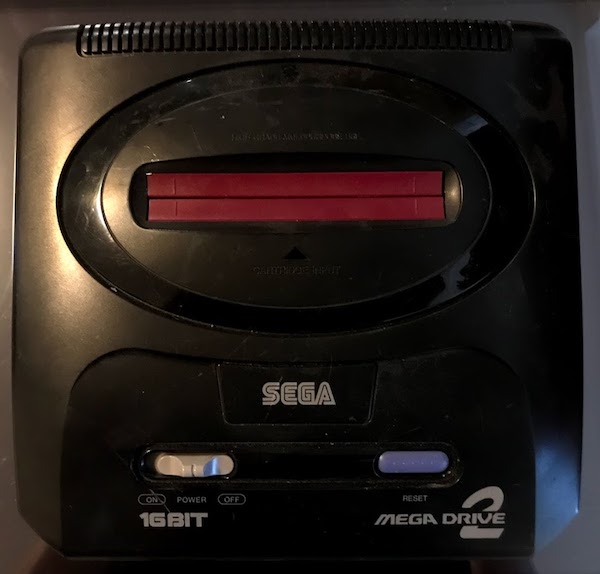
You’ve seen this before in this blog post. This is my Model 2 Mega Drive, and it’s got all the flaws that Model 2s are known for. Poor sound, less than ideal picture quality, the works. But it works, and as noted above, cartridges from any region physically fit in it. No plastic can hold us back.
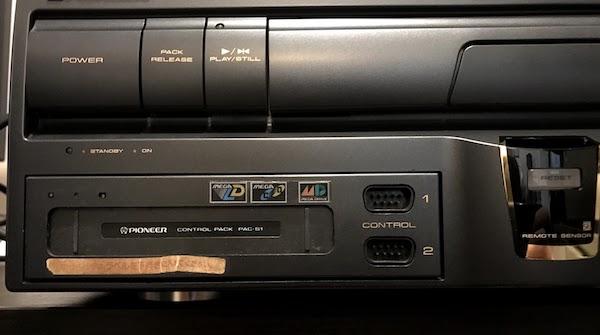
And finally, the PAC S-1, the centerpiece of my last blog post, but really only making a cameo appearance here. It’s like a Model 2 Mega Drive, if it lost its RGB output, and learned how to play Laserdiscs. Is that a fair tradeoff? Well, laserdiscs are cool…
The games
Standard games

Wonder Boy III: Monster Lair and Mystic Defender are our two baseline games. These are standard Genesis and Mega Drive games that don’t do anything special, that have TMSS and the correct plastic cartridge shells, but nothing more.
Wonder Boy III: Monster Lair is a fun test case because its music really does odd things with the sound chip, so it sounds pretty different on different consoles. I’m not sure it sounds good on any of them, though.
You can think of these two games as our control group. If they can make electrical contact with the cartridge slot of a Genesis, they should work. If they don’t, the console is broken.
EA Games
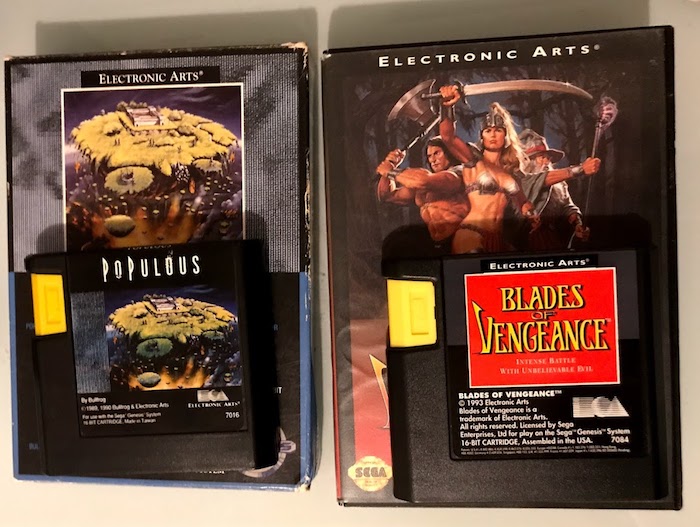
This is a bit more interesting. These are EA games, as you can tell by the weird cartridges with the pointless yellow tabs. Populous is one of EA’s first games for the console, and has no ROM header at all (it’s all zero’d out), and certainly doesn’t do TMSS.
Blades of Vengeance is a later EA title, by the time EA had stopped acting quite so independent and followed some of Sega’s guidelines. They had to to get the games to play on new systems, after all.
Phantasy Star II
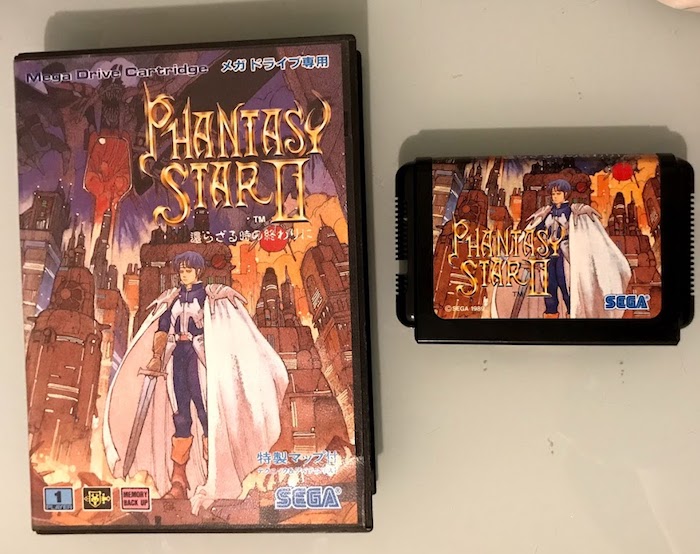
Phantasy Star II was a launch title for the Mega Drive, and happens to be one of my favorite RPGs of all time. However, there’s something a little off about the Japanese version’s approach to TMSS. It has SEGA in its rom header, but never writes it to the magical address.
Therefore, we expect TMSS consoles to not be able to run this game. It’s worth noting that this doesn’t occur in the US release, and all versions can run this.
Oddities
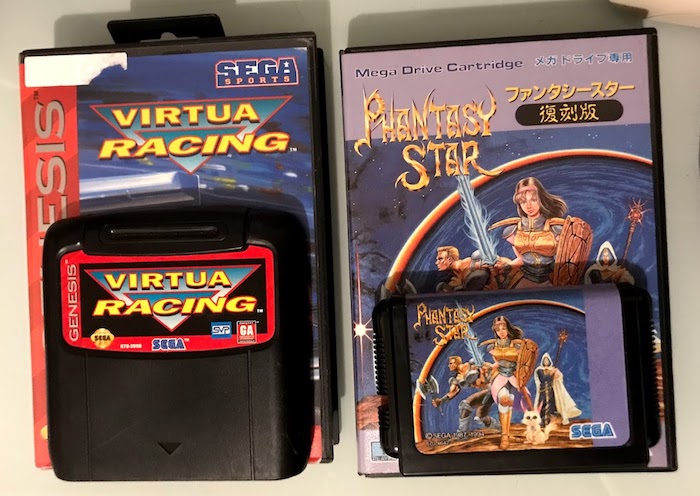
These two Genesis games are a little different than others. Phantasy Star Fukkokuban is a port of Phantasy Star for the Sega Master System. But port is the wrong word. It’s literally the same ROM, but wired internally so that it connects to a Genesis cartridge slot. It’s like you combined a Power Base Converter onto the same PCB.
Virtua Racing is a late Genesis game that’s noted for having an internal on-board chip, the Sega Virtua Processor (SVP). This was in some ways Sega’s answer to the Super FX chip, though arguably the Genesis was more powerful than an SNES with Super FX already.
Test results
Model 1 Genesis
The Model 1 Genesis took everything I threw at it without issue. There was of course no “PRODUCED BY OR UNDER LICENSE FROM SEGA ENTERPRISES LTD.” message before any game. The combination of the Model 1 and a simple cartridge converter to fit the larger games into the slot was enough to play every single one of these games.
It might need its capacitors replaced, though. Eh.
- Mystic Defender: Played fine, as Mystic Defender
- Wonder Boy III: Monster Lair: Required the cartridge slot lengthener, worked fine
- Populous: Ran fine
- Blades of Vengeance: Ran fine, but looked awful
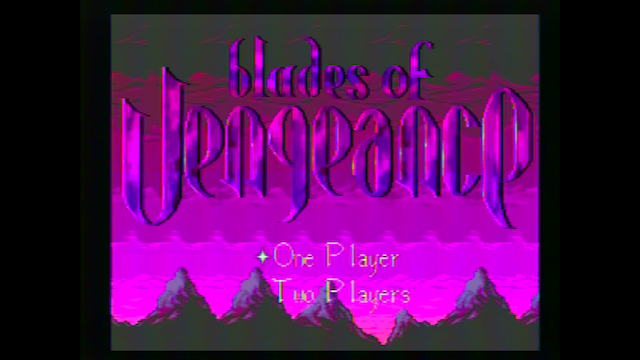
- Phantasy Star II: Required the cartridge slot lengthener. Worked fine.
- Virtua Racing: Worked fine
- Phantasy Star Fukkokuban: Required extender. The game does not work with the Game Genie!
Sega CDX
- Mystic Defender: Played fine, as Mystic Defender
- Wonder Boy III: Monster Lair: Required cartridge slot lengthener, my personal favorite of the music
- Populous: Did not work! Neither the slot lengthener or Game Genie helped, the latter giving a plain red screen
- Blades of Vengeance: Worked great, blades were sharp had plenty of vengeance. Picture looks way better over RGB
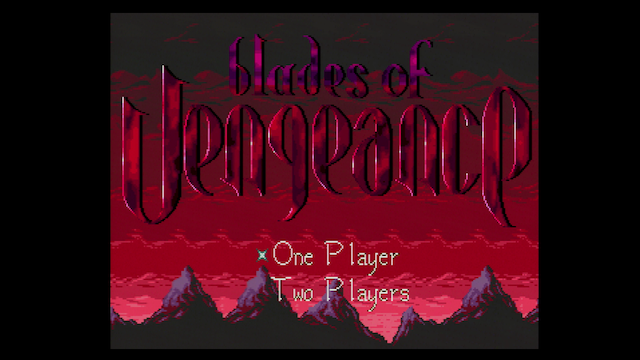
- Phantasy Star II: Required Game Genie. With slot lengthener, displayed the TMSS message but then a black screen.
- Virtua Racing: Worked fine
- Phantasy Star Fukkokuban: Worked fine with slot lengthener
Mega Drive 2 and LaserActive
These systems had no differences. So I’ll spare you going over both. Every cartridge fit in the slot! Both of these consoles displayed the TMSS screen before all Genesis games, but not Phantasy Star Fukkokuban.
- Mystic Defender: Played fine, as Kujaku Oh 2
- Wonder Boy III: Monster Lair: Played fine, worst music of the three
- Populous: Did not work using any method! (But read on)
- Blades of Vengeance: Worked fine, but the blades seemed slightly less vengeful.
- Phantasy Star II: Worked fine! This is also interesting.
- Virtua Racing: Software region lockout
- Phantasy Star Fukkokuban: Worked without issues
The Interesting Ones
So three games really stood out to me here.
Phantasy Star Fukkokuban
For one thing, it seems clear that TMSS doesn’t actually apply to Master System games. The Genesis is a lot like the much later Nintendo Wii, which disabled much of its hardware to play GameCube games. It looks like that happens before TMSS can occur. (If it didn’t, the PowerBase Converter wouldn’t work either)
It’s a bit amusing that the Game Genie doesn’t work, but not surprising. Whichever pins choose SMS mode are likely being passed through, thus causing the Game Genie’s ROM to not load. (And even if it does, the Z80 wouldn’t know what to do with it)
Phantasy Star II
The Japanese version of Phantasy Star II worked fine on every console except for the US CDX.
But this is actually not what I expected. After all, it doesn’t write to the address which is required to turn on the VDP. Therefore, it doesn’t work on the CDX, but I also expected it not to work on the Model 2 Mega Drive and the LaserActive. It works fine on both.
It seems that while these later Japanese consoles contain the boot ROM that checks for “SEGA”, they don’t have the hardware lock in the VDP. But I can’t find this documented anywhere, and indeed I’ve found claims that these launch titles don’t work on later Japanese consoles. Does anyone have a Japanese Mega Drive that refuses to play this game? If so, let me know, and then destroy that console because Phantasy Star II is worth it, damnit.
Finally, the CDX does display the “PRODUCED BY OR UNDER LICENSE” screen, but then blacks out. No sound plays either, so this confirmed to me that the game can’t start.
Populous
Populous doesn’t have TMSS, and doesn’t have a ROM header. It’s also the game that needs the most examination here. The game worked fine on the Model 1 Genesis without TMSS. This was the only form of Genesis when it was coded, so that’s no wonder. But it’s interesting that I couldn’t get it to run on later systems, even with the Game Genie.

But the results with the Game Genie are interesting. Without it, it would just give a black screen on TMSS consoles. But with it, it gives the red screen above. ROM hackers who have dealt with the Genesis might recognize that: it usually means a bad checksum.
The Sega Genesis ROM header has a spot for a checksum; on an old console like this, this is a simple integrity check on the game where the bytes in the ROM are summed up and the sum is compared to the header value. If they don’t match (usually because of a broken or dirty cartridge), it usually gives a red screen.
But the checksum is, as far as I know, done by the game itself, and Populous boots on the Model 1. So the question is, does Populous boot on the Game Genie on the Model 1? Populous does have a checksum, but it doesn’t use the standard setup with the header that Sega games do.

Nope. It seems that the Game Genie is interfering with Populous’s internal checksum. My friend andlabs gave me a Game Genie code, RG6T-R60W, which disables the internal checksum, and this does indeed work.
Apparently, there’s a later revision of Populous with a circled D on the front of the cartridge, which might work differently. Mine doesn’t have that, and doesn’t work. I guess that “Sega Seal of Quality” didn’t mean anything after all.
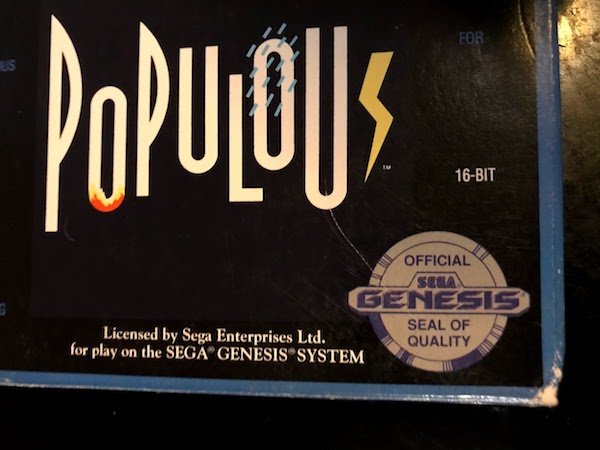
There’s one more thing to try. Remember, TMSS only runs at the start of a game. From then on, the VDP has already been initialized, and obviously no game is going to turn it off. It remains on even when you reset. Therefore, it’s theoretically possible to boot one game without TMSS, and then swap the cartridges.
Since this is a bit dangerous, I’m not going to do it on a system I care about. So that means I tried it on the Model 2 Mega Drive. And it worked!

I’m not going to try it on my Sega CDX because of the risk of damaging the system, but I don’t see why it wouldn’t work. However, don’t do it if you’re in an area where a lot of static electricity could build up, and even then, do it at your own risk.
Conclusions
I hope you found this as interesting as I did! I know that region locks and integrity checks are more annoying than anything else for modern retro gamers, but they are a piece of the history of the console.
To me, the two interesting things, that I didn’t know before starting this are:
- The Japanese version of TMSS is not the same as the Western one!
- The Game Genie interferes with Populous’s checksum check on the game, somehow
Let me know if you think I’ve gotten anything wrong here, or if your consoles give different results.
And next time: Something completely different!
